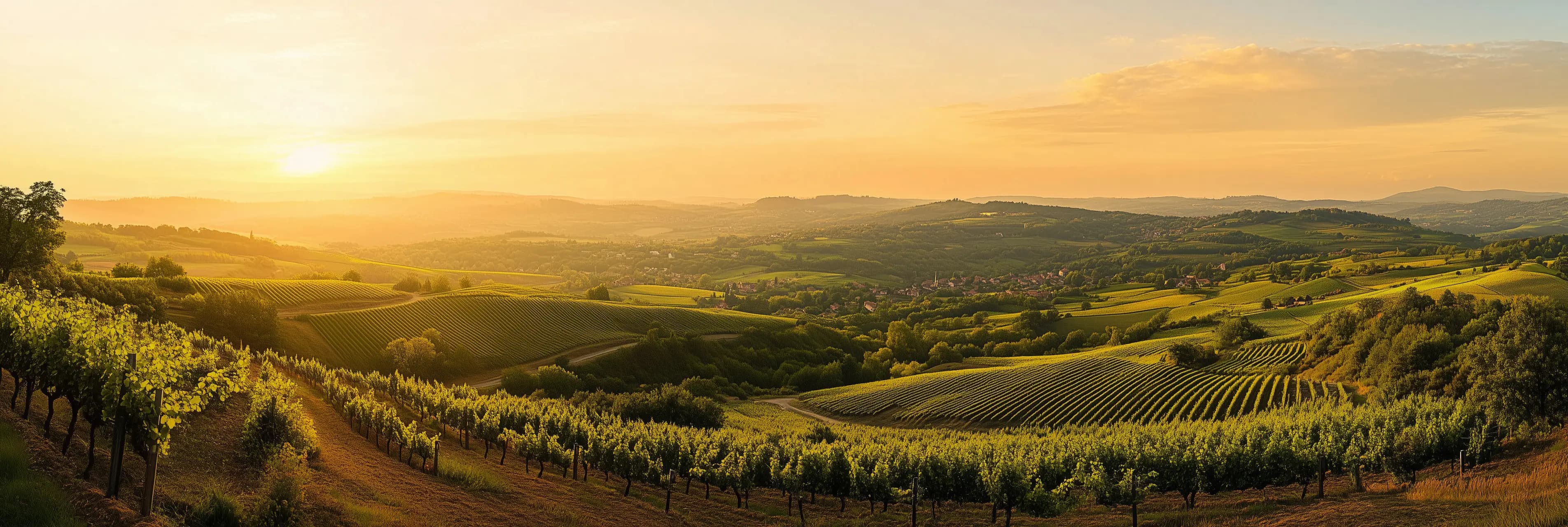Finding the perfect Beaujolais: 5 tips for every wine lover 🍷
Beaujolais is a multifaceted wine region in southern Burgundy that offers much more than its famous Beaujolais Nouveau. While this young and fruity wine is popular worldwide, the region also produces age-worthy, complex wines from its Beaujolais Villages and Cru Beaujolais classifications. To make the best choice when buying a bottle, understanding the appellations, producers, and vintages can enhance your wine experience. In this guide, we’ll explore practical tips for selecting a quality Beaujolais wine that goes beyond the surface.
Tip 1 - Understanding the Beaujolais Wine Classifications
The first step in selecting a Beaujolais wine is to understand the three main categories:
- Beaujolais AOP: These are the most basic wines of the region, typically light, fresh, and meant for early consumption. They are usually the wines released for Beaujolais Nouveau every November.
- Beaujolais Villages: A step up from basic Beaujolais, these wines are sourced from 38 designated villages that produce wines with more structure and complexity. They often come from granite-based soils, which give the wines better minerality and aging potential.
- Cru Beaujolais: The crème de la crème of the region. These wines come from 10 villages, each known for producing distinctive and high-quality expressions of the Gamay grape. Cru Beaujolais wines are more structured and can often benefit from aging. When selecting a wine, knowing whether you want something light and fresh, medium-bodied, or age-worthy will help guide your decision. For everyday drinking, Beaujolais AOP or Villages is a good choice, while the crus offer complexity for special occasions or collectors.
Tip 2 - Focusing on the Beaujolais Crus for quality
If you’re looking for quality and depth, the best place to start is with the Beaujolais Crus.
These wines come from the northernmost part of the region and are more complex than their Nouveau or Villages counterparts. Here’s a breakdown of some of the key cru appellations:
- Moulin-à-Vent: Known for its powerful and structured wines, Moulin-à-Vent wines can age beautifully, developing flavors of spice, dark fruit, and earthiness.
- Morgon: A favorite among sommeliers, Morgon wines offer more richness and can be likened to Pinot Noir from Burgundy. The best examples can age for up to a decade.
- Fleurie: If you prefer a more elegant and floral style of Beaujolais, Fleurie is known for its delicate notes of violet and rose. These wines tend to be lighter and more aromatic.
- Côte de Brouilly and Brouilly: Offering fruit-forward and approachable wines, these two crus are perfect for casual drinking, with notes of red berries and minerality thanks to the volcanic soils in the region. Each cru offers a unique taste profile, so it’s worth exploring several to find your favorite.
Tip 3 - Looking for trusted producers
The reputation of the producer is crucial in selecting a quality Beaujolais. One of the most significant names in the region is Georges Duboeuf, often dubbed the "king of Beaujolais." Duboeuf was instrumental in making Beaujolais Nouveau a global phenomenon, turning the annual release into an eagerly awaited event worldwide. His vision not only popularized the Nouveau style but also shined a spotlight on the region’s more complex Cru Beaujolais. Wines from Duboeuf's portfolio balance tradition with accessibility, making him a trusted producer for both Beaujolais Nouveau and higher-quality crus like Morgon and Moulin-à-Vent. Alongside Duboeuf, other renowned producers have gained a strong following for their focus on natural winemaking. Jean Foillard, Marcel Lapierre, Yvon Métras, and Guy Breton are considered some of the "Gang of Four," a group that championed low-intervention winemaking in Beaujolais. They use organic or biodynamic methods and rely on traditional techniques, such as hand-harvesting and indigenous yeast fermentation, to produce wines that express the true character of the Gamay grape and the unique terroirs of the Cru Beaujolais. By choosing wines from these producers, you’re assured of high-quality craftsmanship, whether you're seeking a lively Beaujolais Nouveau or an age-worthy cru.
Tip 4 - Considering the Vintage
While Beaujolais Nouveau is meant to be enjoyed young, vintage plays a significant role in the quality of Cru Beaujolais. In warmer years, like 2018 and 2020, the wines tend to be richer and fuller-bodied. Cooler vintages, such as 2016, produce wines with higher acidity and finesse, which can be ideal for those who prefer more elegant, lighter styles. If you’re seeking a wine with aging potential, opt for Cru Beaujolais from a strong vintage. Wines from Moulin-à-Vent or Chénas from a good year can develop over 5 to 10 years, revealing complex layers of truffle, dried fruit, and spice.
Tip 5 - Exploring Sustainable Options
More and more Beaujolais producers are focusing on sustainable, organic, or biodynamic viticulture. These wines are not only better for the environment but also often showcase a purer expression of the terroir. Natural wine enthusiasts might particularly enjoy Cru Beaujolais from producers like Domaine Lapierre or Château Cambon, who prioritize minimal intervention and natural fermentation processes. When selecting Beaujolais, seeking out labels that highlight organic certification or natural winemaking can lead you to distinctive wines that stand out in both flavor and character.
Selecting a quality Beaujolais wine requires an understanding of its unique classifications, crus, and producers. Whether you’re looking for something light and fruity like Beaujolais Nouveau, or a more structured and complex wine from one of the crus, there’s something in the region to suit every taste. Pay attention to the producer’s reputation, vintage, and whether sustainable practices are used, and you’ll discover just how versatile and exciting Beaujolais wines can be.

